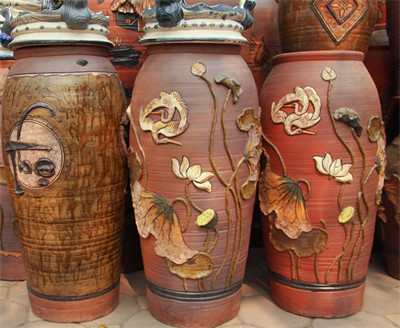How are ceramics and porcelain different?
We often hear about generic words like 'ceramics', so how is pottery, how is porcelain and how to distinguish them? We should thoroughly understand how to choose and distinguish poor quality ceramics.
Pottery has a lower firing temperature than porcelain. Porcelain only baked at the highest level of 1300 degrees Celsius, usually gas ovens only heated to 1280 degrees Celsius. If the temperature is higher, the product will be distorted, frayed or cracked. Pottery has a lower firing temperature, only about 700-800 degrees.
Pottery is a rough piece of wood that has been burned through fire but has no enamel, the material is usually rough.If ceramic is glazed, it must be called porcelain.

Pottery.
Ceramics are products made of clay and its mixtures with inorganic or organic additives, fired through fire. And in a broad sense, ceramics are products produced by baking powdered materials including natural minerals and synthetic inorganic substances including metals.
Depending on the raw materials and processing techniques of raw materials, different types of heating (temperature) create different types of ceramics, popular types are: terracotta pottery, brown clay pottery, porous pottery, white clay pottery, porcelain, porcelain . So, pottery is a common name, and porcelain is one of ceramic products.
Ceramic and porcelain can be glazed, or not (with technical glazes without enamel); and if based on calcination temperature to know it, sometimes it is not true, for example, crockery (coarse pottery), sometimes baked at a higher temperature than it is made, or refractory ceramic, it is baked at high temperatures> 1350 ° C, but it is still called ceramic.
- Pottery is often used in home decoration, vases of flowers, water hyacinths or beautiful ceramic paintings, bricks .
- Porcelain ware is used in kitchens, appliances, dining tables, tea sets, cups, spoons .
Because it is baked at high temperatures and enamelled, it is safe and non-toxic to use porcelain to ensure health safety for family members.

Porcelain dishes.
To distinguish, we use chopsticks or metal rods to lightly tap the product.
- Porcelain products will make the sound longer. Or you can check the enamel on the product.
- Pottery is made from less selective materials than porcelain, so it has a higher porosity, poor heat holding ability, so it has to be enameled with the whole product.
- Check for lead-contaminated porcelain with vinegar and water
- Tips to detect poisoned cups and bowls
- Johann Böttger - The inventor of material is more precious than gold
- Egypt found ceramics in ancient Greek-Roman times
- Family owners discovered treasure when moving house
- 3D printed ceramics make supersonic aircraft covers
- Technical planting and care of Thai porcelain
- Detected 'strange' package in Chinese disk
- The rich in the Middle Ages suffered from lead poisoning due to their preference for ceramics
- Turn the eggshell into a ceramic
- Warning of the risk of poisoning from giant flowers
- Broken teeth because of rapid whitening
 'Fine laughs' - Scary and painful torture in ancient times
'Fine laughs' - Scary and painful torture in ancient times The sequence of numbers 142857 of the Egyptian pyramids is known as the strangest number in the world - Why?
The sequence of numbers 142857 of the Egyptian pyramids is known as the strangest number in the world - Why? History of the iron
History of the iron What is alum?
What is alum?